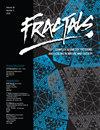Analysis of transmission dynamics of SARS-CoV-2 under seasonal change
IF 2.9
3区 数学
Q1 MATHEMATICS, INTERDISCIPLINARY APPLICATIONS
Fractals-Complex Geometry Patterns and Scaling in Nature and Society
Pub Date : 2023-11-10
DOI:10.1142/s0218348x2350113x
引用次数: 0
Abstract
In this paper, we explore whether the activity of SARS-CoV-2 was associated with seasonality. MF-DFA model is utilized to calculate multifractal strength and multifractal complexity to evaluate the change state of SARS-CoV-2 activity. We select 10 countries with serious epidemic in the world, which are distributed in different latitudes of the northern and southern hemispheres. The study utilized the time series data of daily new cases and daily new deaths recorded in these countries. We regard May to October as the “high temperature season” for countries in the northern hemisphere, November to April as the “low temperature season”, and the southern hemisphere is just the opposite. By comparing the multifractal intensity [Formula: see text] and multifractal complexity [Formula: see text] of the two time series in the two seasons, we draw a conclusion that, for both the sequence of the daily newly diagnosed persons and the daily newly increased number of deaths, in the countries of both the northern and southern hemispheres, [Formula: see text] and [Formula: see text] are weaker in the “low temperature season”. That is, in the low temperature environment, SARS-CoV-2 can survive for a long time and be more infectious. In addition, we also observe that in the northern hemisphere, Iran is at a lower latitude, and although the SARS-CoV-2 activity in the low temperature season is higher than that in the high temperature season, the difference is not significant. Therefore, the lower latitude may resist this phenomenon. However, most of the countries in the southern hemisphere are within 30[Formula: see text] of south latitude, with low latitude, and other meteorological characteristics such as humidity in the countries in the southern hemisphere are also relatively unique. Although SARS-CoV-2 is characterized by high activity in low temperature seasons, no direct evidence related to the characteristics of latitude distribution has been found.季节变化下SARS-CoV-2传播动态分析
在本文中,我们探讨了SARS-CoV-2的活性是否与季节性有关。利用MF-DFA模型计算多重分形强度和多重分形复杂度,评价SARS-CoV-2活性的变化状态。我们选取了世界上疫情严重的10个国家,分布在南北半球的不同纬度。该研究利用了这些国家记录的每日新病例和每日新死亡的时间序列数据。我们把北半球国家的5月到10月称为“高温季节”,把11月到4月称为“低温季节”,而南半球则正好相反。通过比较两个季节两个时间序列的多重分形强度[公式:见文]和多重分形复杂度[公式:见文],我们得出结论:无论是北半球国家还是南半球国家,无论是每日新增确诊人数还是每日新增死亡人数的序列,[公式:见文]和[公式:见文]在“低温季节”都较弱。也就是说,在低温环境下,SARS-CoV-2可以存活很长时间,并且更具传染性。此外,我们还观察到,在北半球,伊朗纬度较低,虽然低温季的SARS-CoV-2活性高于高温季,但差异不显著。因此,纬度较低的地区可能会抵制这种现象。然而,南半球的大多数国家都在南纬30度以内,纬度较低,南半球国家的湿度等其他气象特征也相对独特。虽然SARS-CoV-2具有低温季节高活性的特点,但没有发现与纬度分布特征相关的直接证据。
本文章由计算机程序翻译,如有差异,请以英文原文为准。
求助全文
约1分钟内获得全文
求助全文
来源期刊
CiteScore
7.40
自引率
23.40%
发文量
319
审稿时长
>12 weeks
期刊介绍:
The investigation of phenomena involving complex geometry, patterns and scaling has gone through a spectacular development and applications in the past decades. For this relatively short time, geometrical and/or temporal scaling have been shown to represent the common aspects of many processes occurring in an unusually diverse range of fields including physics, mathematics, biology, chemistry, economics, engineering and technology, and human behavior. As a rule, the complex nature of a phenomenon is manifested in the underlying intricate geometry which in most of the cases can be described in terms of objects with non-integer (fractal) dimension. In other cases, the distribution of events in time or various other quantities show specific scaling behavior, thus providing a better understanding of the relevant factors determining the given processes.
Using fractal geometry and scaling as a language in the related theoretical, numerical and experimental investigations, it has been possible to get a deeper insight into previously intractable problems. Among many others, a better understanding of growth phenomena, turbulence, iterative functions, colloidal aggregation, biological pattern formation, stock markets and inhomogeneous materials has emerged through the application of such concepts as scale invariance, self-affinity and multifractality.
The main challenge of the journal devoted exclusively to the above kinds of phenomena lies in its interdisciplinary nature; it is our commitment to bring together the most recent developments in these fields so that a fruitful interaction of various approaches and scientific views on complex spatial and temporal behaviors in both nature and society could take place.

 求助内容:
求助内容: 应助结果提醒方式:
应助结果提醒方式:


